By the beginning of the 1936-37 season, many of the building blocks that would form the ediface of Warner Bros Cartoons were available to Leon Schlesinger. Both Fred (Tex) Avery and Frank Tashlin were available as directors, and among the animators would be found Charles M. (Chuck) Jones and Robert McKimson. Carl Stalling had just come on board, and Tregoweth Brown had already become the sound-effects expert (in later years billed as “Film Editor”) who would see them through years of production. All this would lead to the glory-days of Warner cartoons.
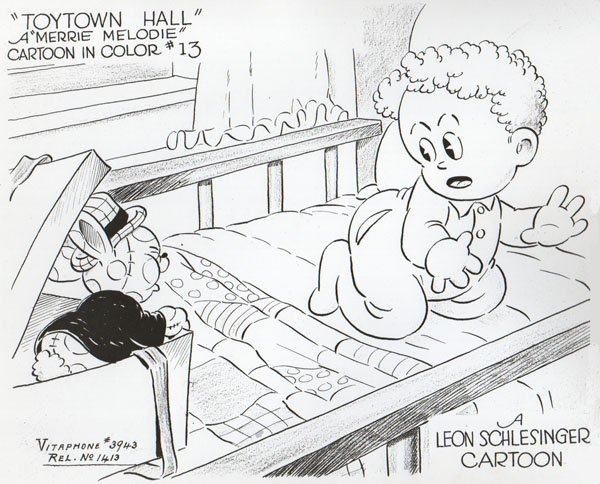
Toy Town Hall (9/19/36) – A little boy wants to stay up and listen to the radio (Ben Bernie and all the Lads on KFWB), when his mother makes him go to bed. The toys in his playroom become a radio revue. Songs (and much animation) are recycled from many previous cartoons, including “Sweet Music”, “Let It Be Me”, “Merrily We Roll Along”, “The Lady In Red”, and “My Green Fedora”.
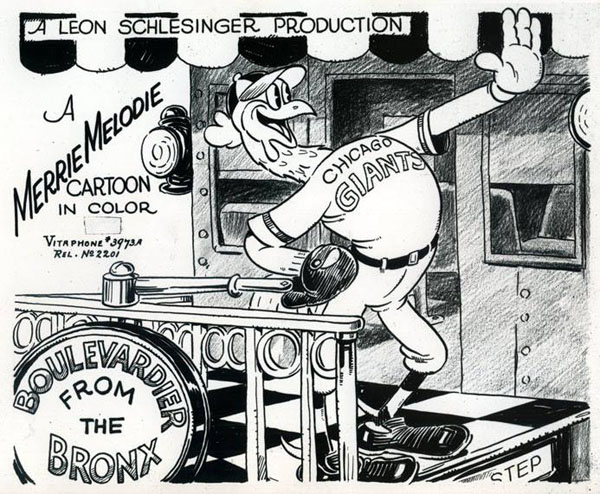
Boulevardier From the Bronx (10/10/36) – The Chicago Giants (a barnstorming baseball team) come to Hicksville to play the local nine. Their star pitcher/batter attracts the attention of one of the local hens (Emily again from “Let It Be Me”), and he seems to reciprocate. The city slicker is determined to show up the country bumpkin. However, the country boy has the last crow. The title song was never recorded commercially, and was introduced by Jack Oakie in the Warner feature, Colleen (embed below). Several other oldies appear, including “It Looks Like a Big Night Tonight” (which was recorded at least three times by Billy Murray in 1908), and more recent tunes including, “Don’t Give Up the Ship”, “Rural Rhythm”, and “Shuffle Off To Buffalo.”
 Don’t Look Now (11/7/36) – Dan Cupid and a little devil vie to see who can one-up the other on their “big day” – Valentine’s Day. Cupid fosters lovey dove-hearts and flowers attitude, while the little devil will have none of it. In the end, Cupid wins, and the little devil falls for a skunk. The title song does not appear to have been recorded. There was a Jimmy Dorsey record released about this time using the title, but it is a different song. Also featured: such oldies and goodies as “Sweethearts Forever”, “Pretty Baby”, “Am I Blue?” and “Brahms’ Lullaby”.
Don’t Look Now (11/7/36) – Dan Cupid and a little devil vie to see who can one-up the other on their “big day” – Valentine’s Day. Cupid fosters lovey dove-hearts and flowers attitude, while the little devil will have none of it. In the end, Cupid wins, and the little devil falls for a skunk. The title song does not appear to have been recorded. There was a Jimmy Dorsey record released about this time using the title, but it is a different song. Also featured: such oldies and goodies as “Sweethearts Forever”, “Pretty Baby”, “Am I Blue?” and “Brahms’ Lullaby”.
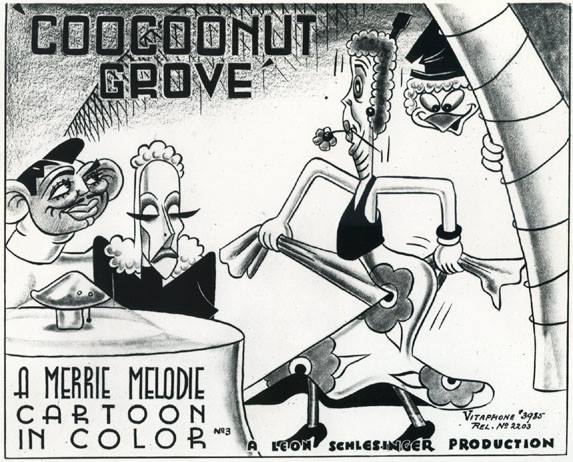
The Coo Coo Nut Grove (11/28/36) – A night at a south seas night club populated by celebrity caricatures. This club has all the modern conveniences, including a light-up sign operated by fireflies. Music is provided by Ben Birdie and all the lads, with interruptions by reporter Walter Windpipe. Other “celebrooties” include Tarzan and Jane, Laurel and Hardy, Harpo and Groucho Marx, George Raft and Edward G. Robinson, and a torch song by Helen Morgan. Songs: “Through the Courtesy Of Love”, about which we’ve discussed before”, “About a Quarter To Nine”, introduced by Al Jolson in the Go Into Your Dance, “My Old Man” (as if it were sung by the Dionne Quintuplets), and “The Little Things You Used To Do” as the Helen Morgan tear-jerker that floods the club and washes performers and audience out to sea. That’s embed below – from the aforementioned 1935 Warner feature Go Into Your Dance. “Little Things” was also recorded for royal blue Columbia by Johnny Green and his Orchestra, and for Bluebird by a Jack Shilkret studio group with anonymous vocal that turns out to be Dick Robertson.
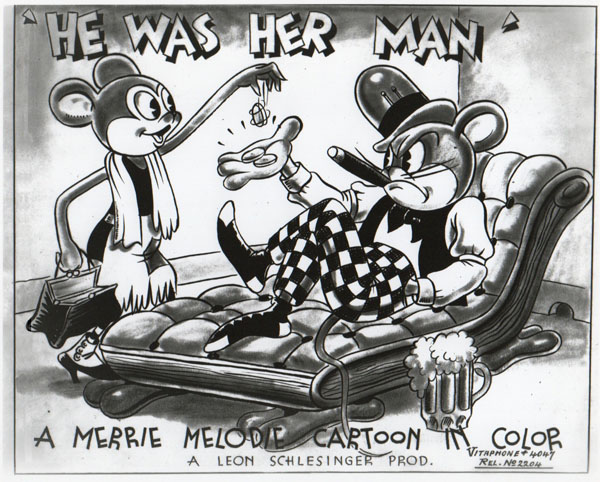
He Was Her Man (1/2/37) – A hen mouse is in love with a man who mistreats her tremendously, and makes her sell apples out in the snow, while he reads the paper before a nice warm fire. He looks her up at a dive where she’s making a little extra money singing for noisy customers. She shoots and manages to “wing” him. By the end of the cartoon, he’s out in the snow selling apples, while she’s taking it easy in their ramshackle shanty. The title song was introduced in the 1935 Warner musical Broadway Hostess, by Wini Shaw, embed below, who gives it the same torch song treatment that it gets in this cartoon. Other songs include “Fancy Meeting You (The Evolution Song)”, recorded by Jolly Coburn on Victor, “I’d Love To Take Orders From You”, and the familiar old Apache Dance.
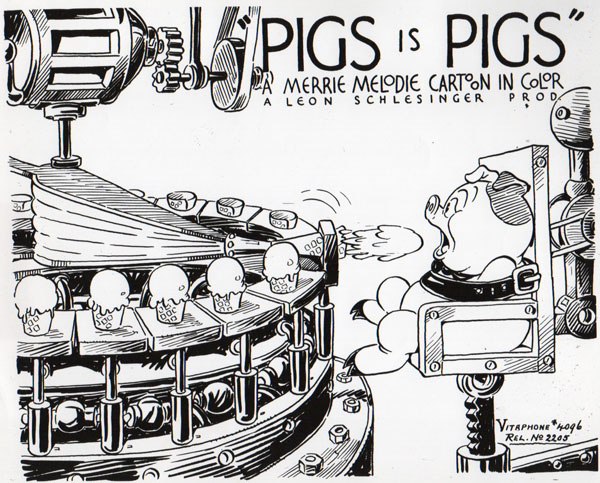
Pigs Is Pigs (1/30/37) – Not to be confused with any Walt Disney cartoon of the 1950’s. While Mama Hamhock’s children are mostly interested in play, Piggy dreams of food – and no shortage of it, either. At the table, he is very rude, and tries to get as much food as he can, but is warned of the hazards of overeating by his mother, who claims that indigestion will get him for sure. Piggy dreams that he is taken by a hiccuping mad-scientist into a frenzy of force-feeding. The scientist has all sorts of mechanical contraptions to accomplish the purpose, automatically dispensing soup, bananas, ice cream, pies (from a pie juke-box), and a sandwich (possibly with one of the earliest uses of Friz Freleng’s favorite “Hold the Onions” sign gag). Despite being filled to the gills, Piggly learns nothing and is still hungry, taking one more bite – at which he explodes, awakening him from the dream. In real life, he still remains unteachable, and still consumes food with gluttony. Songs: “When My Dreamboat Comes Home”, used as a light motif for Piggy’s dream, “Puppchen”, used as a cue for Mama, and one of the first uses of “Half of Me (Wants To Be Good)”, first used in a Warner live action short, The Black Network, introduced by Nina Mae McKinney.
I Only Have Eyes For You (3/6/37) – Katie Canary is the light in the eyes of a travelling iceman – but she only has eyes for a radio crooner. Another less attractive female pursues the iceman, hoping the way to this man’s heart is through his stomach. The iceman enlists the asssistance of Professor Mockingbirsd, an imitator who will imitate the radio crooner from the back of the ice wagon while our hero lip-syncs. Everything seems to work until the professor develops a severe cold on the ice blocks in the back of the wagon. In the end, Katie falls for the professor, and trades in her ice-box for a “church-top” refrigerator, while the iceman settles down with the ugly dame who, at least, can cook!
The title song, the big ballad from Dames, became a standard, and would be revived in 1959 by the Flamingoes. It’s barely heard in the final cartoon, but I’m compelled to post the embed below. “Let It Be Me”, “Listen To The Mocking Bird” (1851), “Put On Your Old Gray Bonnet” (1910)’, and a recent hit, “All’s Fair In Live and War” (from Gold Diggers of 1937) also appear. “Love and War” was introduced by Dick Powell, who recorded it for Decca. A dance version was also given on Decca to Henry Busse, and another appeared by Vincent Lopez on Melotone et al.
The Fella With the Fiddle (3/27/37) -An old grandfather mouse tells his young-uns a cautionary tale about greed. The kids listen attentively, but one of them notices a tell-tale object from the story in Gramps’ pocket that makes them doubt Gramps’ veracuty – a golden cat’s tooth. The title song was never recorded commercial as far as I know. Carl Stalling used it as a light motif for Porky Pig’s happier moments. Other songs include “With Plenty of Money and You”, a song which we’ll meet again below.
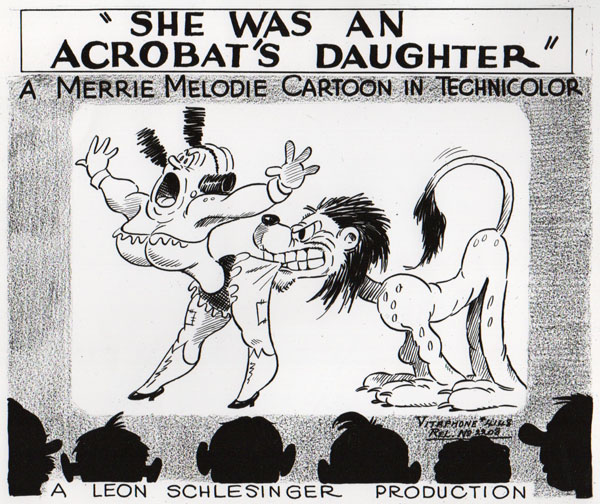
She Was an Acrobat’s Daughter (4/10/36) – One of the many Warners’ “theatre” cartoons, which episode would provide a cornucopia of stock footage they could reuse in later cartoons (especially in 1946’s Bacall to Arms). A typical night at the movies, with gags appearing onscreen, in the audience, and even in the projection booth. Songs include the title song, which we have met before; “Through the Courtesy of Love”, “Meow”, and “Nagasaki”, the latter used for the first time in a Warner cartoon, a 1928 song that became a favorite with jazz musicians and swing arrangers, to the point where it was described as “the National Anthem in Harlem”. Contemporary versions included the Mills Brothers on Decca, Fletcher Henderson on Decca, and from the U.K. Nat Gonella and his Georgians on Parlophone. It would be recorded with complete text in 1959 by Bobby Short on Atlantic.
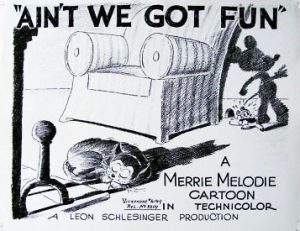 Ain’t We Got Fun (4/17/37) – An old codger mistreats his cat, thinking the cat is making a mess of the place. It’s really a bunch of little mice who’ve been raiding the pantry and partying.
Ain’t We Got Fun (4/17/37) – An old codger mistreats his cat, thinking the cat is making a mess of the place. It’s really a bunch of little mice who’ve been raiding the pantry and partying.
We’ve heard the title song in other Warner cartoons (and we’ll hear it again). “Memories”, a 1915 song considered an evergreen at the time (which we’ll meet again a few years down the line), was also featured.
“All’s Fair in Love and War” from Gold Diggers of 1937, also appears – and this is as good a place as any to embed this Dubin and Warren favorite used by Stalling on numerous occasions.
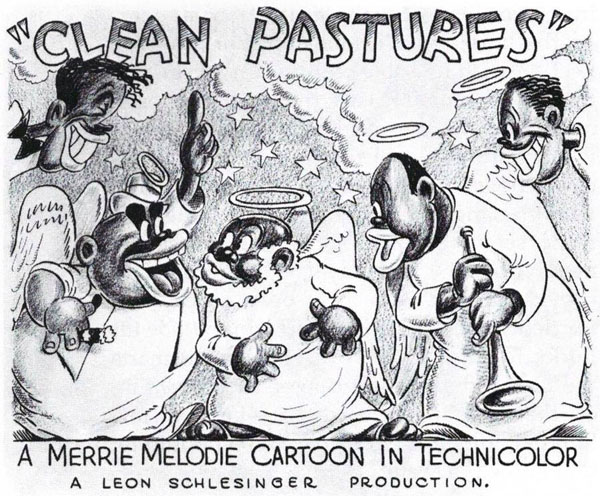
Clean Pastures (5/22/37) – The stock of “Pair-o-dice Preferred” is doing a Wile E. Coyote fall, while the stock of Hades, Inc. is booming. The angels that have been sent down to convert Harlem from sinful night life haven’t been doing a very good job of it. Angels with more modern ideas than the Stepin Fetchit angel sent previously prove to be considerable more successful with their swing music. The modern angels make Pair-o-dice seem so attractive, even Lucifer wants to get in! Music: “Save Me, Sister” is heard over the opening title, another song from The Singing Kid (1936) which was recorded by Cab Calloway for Brunswick, and apparently by nobody else. “Sweet Georgia Brown”, which we’ve heard in one of the earlier cartoons reviewed in this column; “Swanee River”, the old Stephen Foster chestnut; and “Oh, Dem Golden Slippers”, are heard. “Swing For Sale”, another song associated with Cab Calloway and recorded for Brunswick, is given a full production number (footage of which would be lifted verbatim for use in Frank Tashlin’s Have You Got Any Castles? (1938). This film made Warner’s “Censored 11″ list, despite its clever plot and lively musical score.
Here’s the Mills Brothers beautiful take on “Swing For Sale”:

Uncle Tom’s Bungalow (6/5/37) – Obviously a spoof of Uncle Tom’s Cabin, or the better-known parts of it, Tex Avery style. The origin of some of Tex’s favorite tropes, including characters tired of going through the same old motions again and again. Songs include some old favorites – “Dixie” and “Swanee River”, and “Are You From Dixie?” a 1918 chestnut that had been recorded in the day by Billy Murray and Irving Kaufman for Victor. Also appearing again, “With Plenty of Money and You”, and “My Little Buckaroo”, a pseudo-Western ditty we will meet again. Another of the “Censored 11″.
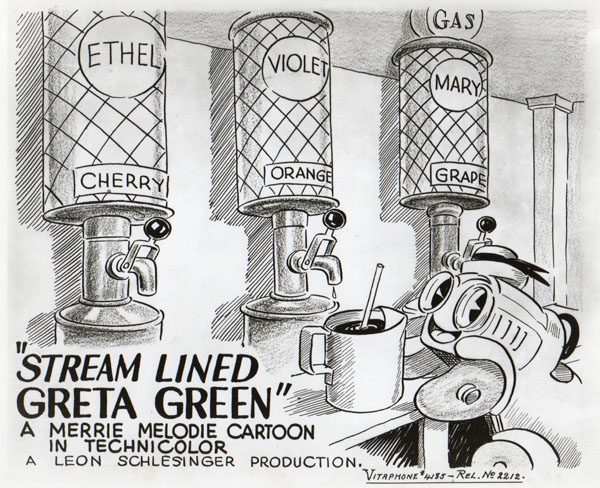
Streamlined Greta Green (6/19/37) – The life-cycle of a car – Junior wants to be a Taxi cab, while mother wants him to be a touring car. Junior’s misadventures wind him up in the repair shop – but in spite of everythng he still hasn’t learned not to race trains. The title song was recorded in 1935 by the Little Ramblers for Bluebird (see embed below) – and apparently for no other label. It’s possible that the vocal in the cartoon was by the 5 Jones Boys, one of the few black vocal groups on the West Coast at the time. Other songs include “Shuffle Off To Buffalo”, “Lullaby of Broadway”, and “Little Man, You’ve Had a Busy Day”.
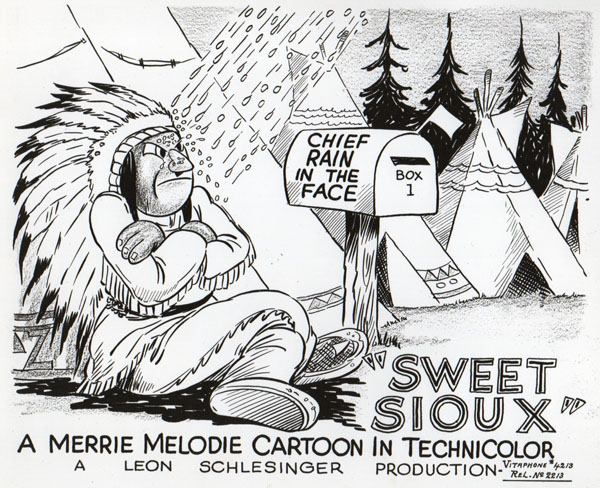
Sweet Sioux (6/26/37) – Indians pursue settlers trying to cross their domain. In the ensuing fracus, nobody goes unscathed. Includes “Pale Moon”, a concert song with an American Indian setting, Stephen Foster favorite “Oh Susanna”, and “Freddie the Freshman” as the Indians engage in a college-style rally.
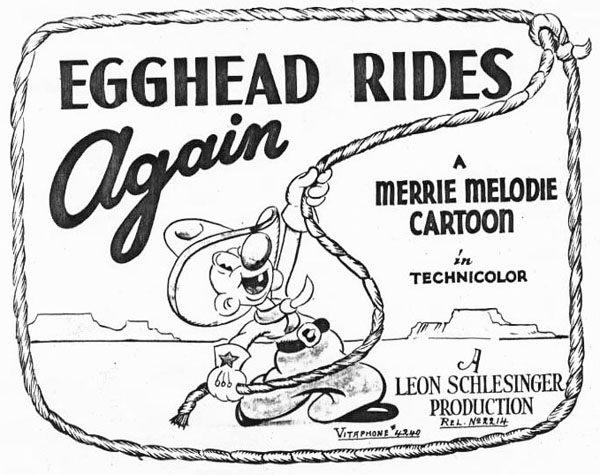
Egghead Rides Again (7/17/37) – The introduction of the character who would (some say) eventually evolve into Elmer Fudd. Egghead begins his film career by getting booted out of hs boarding house for overactive play-acting while reading “Western Story “ magazines. He answers a want-ad from the Bar-None Ranch in Wyoming. His efforts to do all sorts of cool cowboy stuff are quite the embarrassment, but he does gain employment at the ranch – as a sanitary engineer. Tunes include “Lullaby of Broadway”; a yodeling cowboy number which is possibly an original; and several western-style compositions which would become standard Stalling Western cues for years to come – those from Warner’s Dick Foran B-Westerns: “Song of the Circle Bar” from Land Beyond The Law and “When A Cowboy Takes A Wife” from Guns Of The Pecos (both by MK Jerome and Jack Scholl).

Plenty of Money and You (7/31/37) – Life on the poultry farm, with a weasel making regular raids on the populace – except this time he picks up an ostrich instead of a chicken, who eats everything in sight. This nasty habit proves handy and saves the ostrich’s life, after she swallows fireworks and the heat of a nearby oven causes one heck of a reflux! The title song appears with a special material lyric for what the weasel has in mind – “With Plenty of Gravy on You”. Recordings include Dick Powell on Decca, Henry Busse, on Decca (embed below), and Hal Kemp on Brunswick.
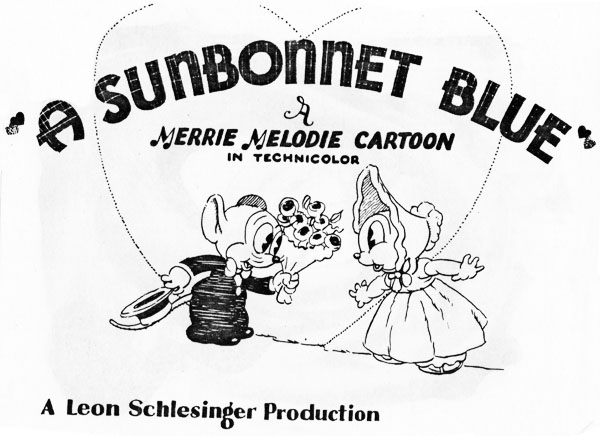
A Sunbonnet Blue (8/21/37) – Mice cavorting at the Snobby Hatte Shoppe, joined by an evil rat who winds up engaging in the boy-girl-villain routine of several Warner cartoons. Music includes “The Japanese Sandman”, a 1920 pop song recorded by Paul Whiteman for Victor and Isham Jones for Brunswick, Art Hickman on Columbia, and Frank Trumbauer with Bix Beiderbecke for Okeh in 1928. Whiteman would re-record the number electrically in 1928 for Victor. “The Little Old Fashioned Music Box” was recorded possibly for transcriptions by Nick Lucas”. “I Haven’t Got a Hat” appears in a medley with “Put On Your Old Gray Bonnet” and “The Lady in Red”, performed by the Three Ratz Brothers.
The title song of the cartoon is a 1935 number recorded fairly widely. Victor gave in to Enric Madriguera and his society band, while Brunswick gave it to Teddy Wilson’s all-star combination with Billie Holiday, and Melotone et al. had a version by Chick Bullock and his Levee Loungers (a Russ Morgan studio band). The film ends with a swing arrangement of The Wedding March, and a wedding present from the mice of a live-action shot of a baby bonnet.
Next time: Looney Tunes 1937-38: From Strength to Strength.


 James Parten has overcome a congenital visual disability to be acknowledged as an expert on the early history of recorded sound. He has a Broadcasting Certificate (Radio Option) from Los Angeles Valley College, class of 1999. He has also been a fan of animated cartoons since childhood.
James Parten has overcome a congenital visual disability to be acknowledged as an expert on the early history of recorded sound. He has a Broadcasting Certificate (Radio Option) from Los Angeles Valley College, class of 1999. He has also been a fan of animated cartoons since childhood.












































I love the lavish use of the lobby cards in this post, most of which I’ve never seen before. Cherry on top of the sundae of the music.
Musically “Sweet Sioux” is probably most notable for the first use of “The Merry-Go-Round Broke Down” by Carl Stalling, as part of the gag where the attacking Indians circling the wagon turn into a merry-go-round like ride.
Hopefully those censored eleven will see the light of day for us big kid enthusiasts. Neat post.
This is a terrific series. Thank you, James!
I love your “Way Too Damn Lazy” blog, Paul, but did you stop publishing comments, or is there a glitch?
“The Fella With the Fiddle” was also Mel Blanc’s first “Merrie Melodies” cartoon. He not only proved he had potential as a voice actor, he could also SING!
Thank you for an amazing post!
Da skirt in He Was Her Man is a mouse, not a hen, ya mug! (She’s even on da lobby card dere).
I wonder if full versions of “Don’t Look Now”and “Plenty Of Money And You” exist. Current prints seem to have footage missing.
What a same that cartoons featuring caricatures of the great black entertainers of the Jazz Age have to be “censored.” If “Coo-Coo-Nut Grove” is any example (and of course it is), white stars were lampooned just as irreverently. If the black characters were depicted as subservient to white characters, or portrayed as somehow “lesser,” there might be cause for concern. And don’t Stepin Fetchit me: Mr. Fetchit was the first African-American performer to become a millionaire, so there.
On the other hand, considering how animators depict African-Americans at the time, had they had African American star caricatured in that short, they would eventually be edited out in contemporary television airings.
Again, it’s “leitmotif,” not “light motif.”
Boulevardier From the Bronx is one of My favorites!
Excellent post!!
Not sure (because of all the “Blue Ribbon” re-filmed title cards) but wasn’t “Boulevardier From The Bronx” the first Merry Melody to use “Merrily We Roll Along” as the opening theme music?
Yes. Toy Town Hall was the final Merrie Melody to use “I Think You’re Ducky” as the theme.
#FunFact: Boulevardier Of The Bronx was the first Merrie Melody to make use of its theme “Merrily We Roll Along.”
The mice couple’s cockfight-like confrontation in He Was Her Man has the Valse des Rayons from Offenbach’s ballet Le Papillon played under it, an old favorite of Stalling who accompanied such scenes with this music like in Iwerks’ Rasslin’ Round 3 years before.
If “Speaking of the Weather” was given a release number of 2216, and “Dog Daze” that of 2217, then “A Sunbonnet Blue” would be number 2218.
~Ben